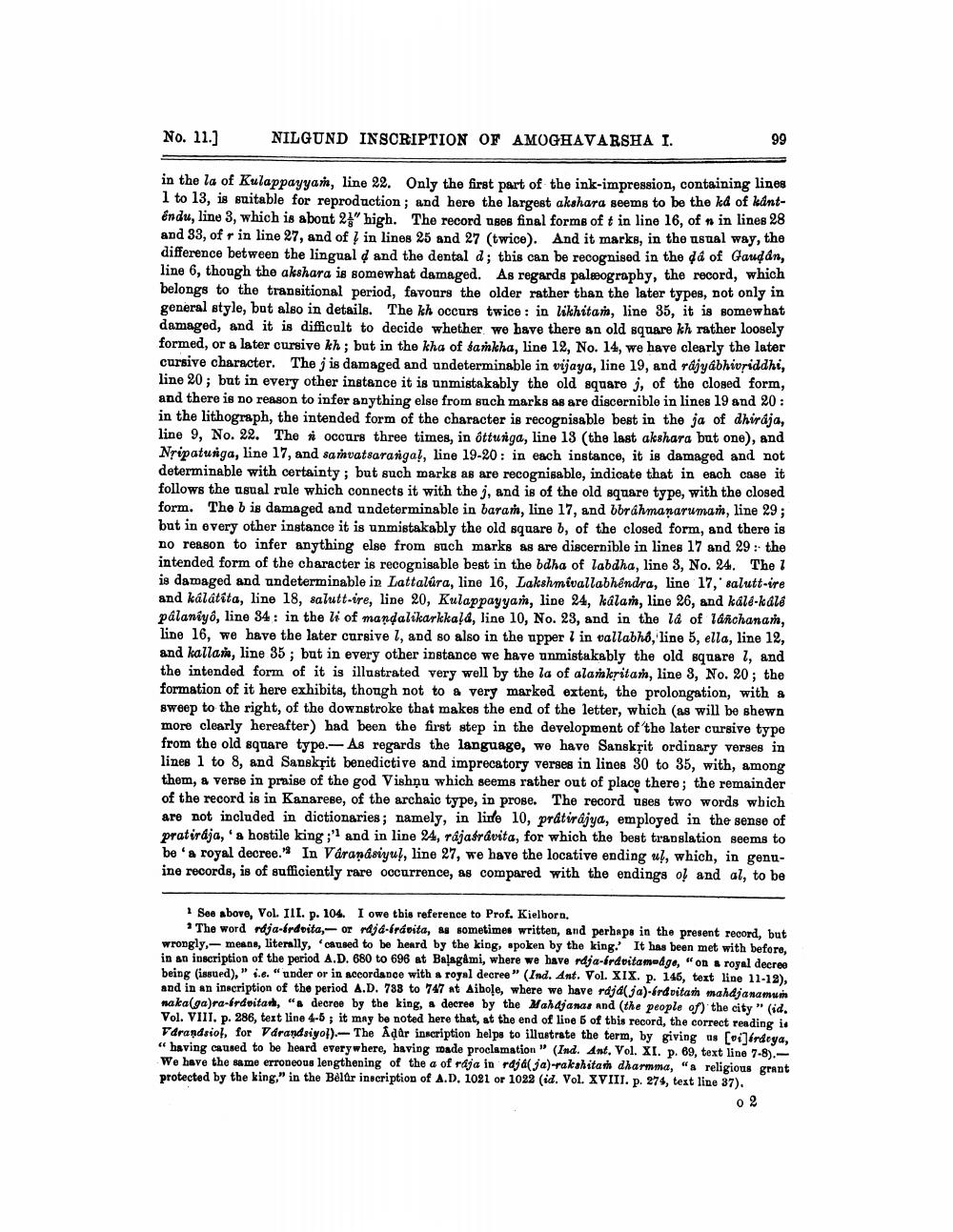________________
No. 11.)
NILGUND INSCRIPTION OF AMOGHAVARSHA I.
99
in the la of Kulappayyan, line 22. Only the first part of the ink-impression, containing lines 1 to 13, is suitable for reproduction; and here the largest akshara seems to be the kd of kdntendu, line 3, which is about 2"high. The record nges final forms of t in line 16, of in lines 28 and 33, of r in line 27, and of in lines 25 and 27 (twice). And it marks, in the usual way, the difference between the lingual d and the dental d; this can be recognised in the då of Gandan, line 6, though the akshara is somewhat damaged. As regards palæography, the record, which belongs to the transitional period, favours the older rather than the later types, not only in general style, but also in details. The kh occurs twice: in likhitan, line 35, it is somewhat damaged, and it is difficult to decide whether we bave there an old square kh rather loosely formed, or a later cursive kh; but in the kha of samkha, line 12, No. 14, we have clearly the later cursive character. The j is damaged and undeterminable in vijaya, line 19, and rajyabhiosiddhi, line 20; but in every other instance it is unmistakably the old square j, of the closed form, and there is no reason to infor anything else from such marks as are discernible in lines 19 and 20: in the lithograph, the intended form of the character is recognisable best in the ja of dhiraja, line 9, No. 22. The si occurs three times, in ôttunga, line 13 (the last akshara but one), and Nripatunga, line 17, and sainvatsarangal, line 19-20: in each instance, it is damaged and not determinable with certainty ; but such marks as are recognisable, indicate that in each case it follows the usual rule which connects it with the j, and is of the old square type, with the closed form. The b is damaged and undeterminable in baran, line 17, and bbrahmanaruman, line 29; but in every other instance it is unmistakably the old square b, of the closed form, and there is no reason to infer anything else from such marks as are discernible in lines 17 and 29: the intended form of the character is recognisable best in the bdha of labdha, line 3, No. 24. The ? is damaged and undeterminable in Lattalúra, line 16, Lakshmivallabhêndra, line 17,' salutt-ire and kálátita, line 18, salutt-ire, line 20, Kulappayyan, line 24, kalan, line 26, and káld-kale palaniyo, line 34: in the li of mandalikarkkaļd, line 10, No. 23, and in the lå of lánchanan, line 16, we have the later cursive 1, and so also in the upper l in vallabho, line 5, ella, line 12, and kallar, line 35; but in every other instance we have unmistakably the old square 1, and the intended form of it is illustrated very well by the la of alarakitan, line 3, No. 20; the formation of it here exhibits, though not to a very marked extent, the prolongation, with a sweep to the right, of the downstroke that makes the end of the letter, which (as will be shewn more clearly hereafter) had been the first step in the development of the later cursive type from the old square type.- As regards the language, we have Sanskrit ordinary verses in lines 1 to 8, and Sanskrit benedictive and imprecatory verses in lines 30 to 35, with, among them, a verse in praise of the god Vishnu which seems rather out of place there; the remainder of the record is in Kanarebe, of the archaic type, in prose. The record uses two words which are not included in dictionaries, namely, in lide 10, prátirajya, employed in the sense of pratiraja,' a hostile king ;' and in line 24, rajafrávita, for which the best translation seems to be a royal decree. In Varanasiyul, line 27, we have the locative ending ul, which, in genuine records, is of sufficiently rare occurrence, as compared with the endings of and al, to be
See above, Vol. III. p. 104. I owe this reference to Prof. Kielborn,
* The word rdja-Ardoita,- or rdja-frávita, as sometimes written, and perhaps in the present record, but wrongly,-- means, literally, caused to be heard by the king, spoken by the king. It has been met with before, in an inscription of the period A.D. 680 to 696 at Balagámi, where we have rdja-brdoitamedge, "on a royal decree being (issued), " i.."under or in accordance with a royal decree" (Ind. Ant. Vol. XIX. p. 145, text line 11-19), and in an inscription of the period A.D. 788 to 747 at Aibole, where we have rdja(ja)-6rdvitan mahdjanamu naka(ga)ra-irdvitar, "s decree by the king, a decree by the Mahdjanas and the people of) the city” (id. Vol. VIII. p. 286, text line 4-6, it may be noted here that, at the end of line 5 of this record, the correct reading is Farandsiol, for Várandsiyol).--The Addr inscription helps to illustrate the term, by giving us [vi]Ondoya, “having caused to be heard everywhere, having made proclamation" (Ind. Ant. Vol. XI. p. 69, text line 7-8). - We have the same erroneous longthening of the a of raja in rdja(ja)-rakahitan dharmma, "a religious grant protected by the king," in the Beltr inscription of A.D. 1021 or 1022 (id. Vol. XVIII. p. 274, text line 37).
02




